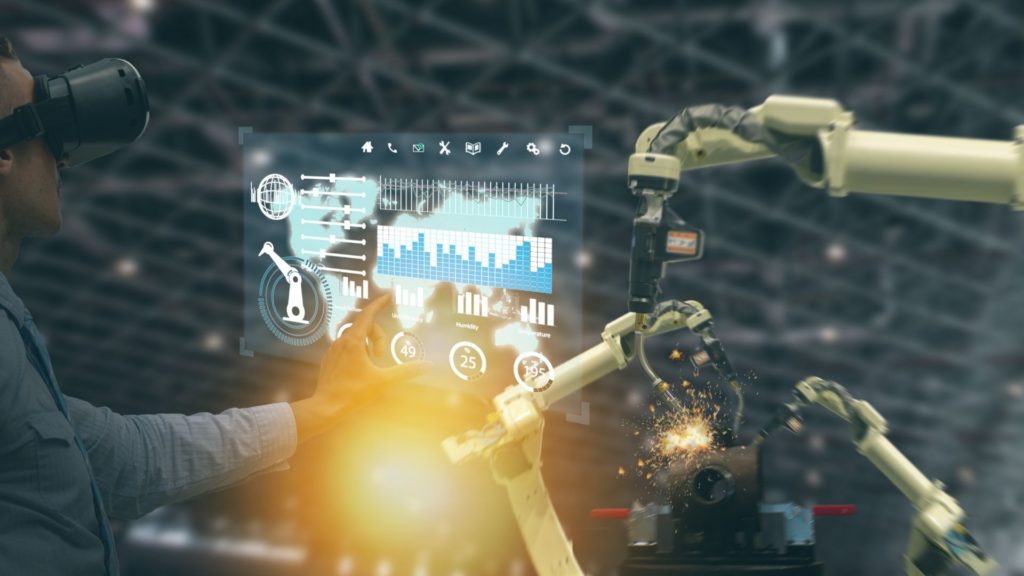Digital factory transformation: intelligent manufacturing

The industry is experiencing an unprecedented acceleration in digital transformation, process automation and human-machine interaction technologies in the context of COVID-19.
Indeed, as businesses begin to adapt to the severe disruption caused by the pandemic and a protracted recovery process; investment in intelligent manufacturing has become a key strategic priority for industries at all levels
Intelligent manufacturing
Firstly, intelligent manufacturing is defined as fully integrated collaborative manufacturing systems; acting in real time to respond to changing demands and conditions on the factory floor.
So, for industry players; adoption of these systems is essential to increase agility and operational performance; address safety requirements and labor shortages caused by social distancing demands; and create a fully networked manufacturing process that facilitates greater visibility over input/output variables and their connection.
The aim is to generate KPIs in real time.
The intelligent factory
Firstly, the smart factory represents a new manufacturing paradigm for the coming decade.
Thus, the emergence of commercially viable IoT devices; 5G connectivity, sophisticated cloud computing applications and megadata analysis; combined with new technologies such as AR / VR, represent an unprecedented fusion of the physical and digital worlds.
Indeed, a Deloitte study published in 2019 estimates that the adoption of smart factory initiatives; can help the US manufacturing sector triple the manufacturing labor productivity rate in the 2030 horizon.
In fact, existing investments are already contributing to an average increase of 10% in production; 11% in plant capacity utilization and 12% in labor productivity.
In addition, 86% of manufacturers believe that smart factory initiatives will be; the main driver of manufacturing competitiveness in five years' time, and have allocated 30% of the overall factory budget to smart factory solutions.
Intelligent manufacturing technologies
The main intelligent manufacturing technologies can be classified into each of the following three categories:
Data and connectivity:
Deploying IoT sensors in manufacturing processes and the supply chain; enables companies to collect large amounts of data on an unprecedented scale.
As a result, previously siloed systems can now offer companies greater visibility over the entire production process. So, reducing peak/cloud computing, storage and bandwidth costs has brought the Digital Twin within reach.
The digital twin is a digital representation of the physical and behavioral characteristics of production machines and finished products, enabling companies to quickly identify problems, carry out accurate simulations and uncover operational inefficiencies in real time.
Digitized standard operating procedures:
Advanced analytics enable manufacturers to dive deep into historical process data; identify patterns and relationships between inputs and outputs; and optimize the factors that have the greatest impact on performance.
For example, the implementation of new AI analysis platforms in 2020 have enabled an estimated ;20% reduction in cleanroom investments; as well as a 10% reduction in production time and a return on investment of up to 300%.
In addition to its application to improve manufacturing processes; data analysis has also been harnessed to improve worker productivity and safety through the analysis of health; injury and incident data.
Advanced human-machine interaction:
The adoption of virtual reality (VR), augmented reality (AR) and collaborative robots (cobots) has enabled a new level of human-machine interaction for manufacturers; improving factory throughput, speeding up worker training, and reducing workplace risks.
For example, the application of VR has enabled Ford to simulate the car manufacturing process and reduce work-related accidents by up to 70%.
Thanks to AR, technicians are able to quickly understand how to maintain and repair faulty equipment by superimposing schematics or instructions on the physical object. Indeed, cobots (safe enough to work alongside humans) facilitate work processes carried out in collaboration with human workers to improve productivity - in some cases by as much as 50%.
So, to reap the full benefits of this emerging paradigm; manufacturers should look beyond traditional sources to proactively co-develop solutions with startups and other external partners.
So, thoughtful, targeted adoption of smart manufacturing technologies is essential to prepare workers and businesses for long-term success in the decade ahead.
Indeed, it will be crucial to adapt and capitalize on key developments, including artificial intelligence and offshoring of manufacturing.
Need an expert opinion?
Follow our innovations on social networks
We frequently publish on social networks (Linkedin, Twitter and Medium) our innovations and the new functionalities of our industrial management solutions.
Also, we would be happy to share with you the latest trends in industrial management 4.0 through high quality content that you could share with others.



